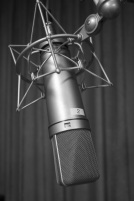The Spoken then Heard Word
I’m terrified by how quickly spoken language disappears. The breath we take in and the vibrations, that shaped air, passing our tongues. What we say, though remembered, lives only so long on the air. But how powerful in those moments? Primal. Physical enough to pound a drum, shake bone, and wave cilia. But still so fleeting. There, then gone. Gone as soon as you close your mouth and stop humming.
So, here’s how this works . . .
Using some kind of online audio sharing platform (Soundcloud is my favorite), upload/record your voice and share the URL in the comments below. To organize, I’ve preloaded comments with the prompt numbers, so you can reply to the comment which designates the prompt you’re responding to . . . Blah, blah, blah, right?
Now let’s speak and be heard!
Prompt 1: Brainstorm a list of five textural adjectives (smooth, grainy, etc.). Take your list and brainstorm five words for each adjective whose sound reflects the texture. Take the twenty-five words and read them aloud. Reorder them. Read them aloud again. Record and listen to yourself. Play with the order as many times as you’d like until you find your favorite order.
Record and post.
Prompt 2: Understanding the aural texture/movement/tension of words relies somewhat on our ability to comprehend/get/recognize/feel the textures of the sounds around us. Go to a busy place. Close your eyes for five minutes. Make as little noise as possible and listen to the sounds around you. Have a paper with you and write any words that come to mind as you listen. Open your eyes and move about the busy space but DON’T STOP listening. Hear you in the space. Take as long as you need and keep adding words to the list. Go home. Take a little break. Nap. Eat something. Then return to the list of words you’ve made and read them aloud once. Put the list away. Write a poem. Read the list again. Revise your poem. Read the list again. Read your poem. Revise.
Record and post.
Prompt 3: Find a dictionary. Flip it open seven times. Each time, read the words on the page and find one that rolls most easily off your tongue or the one you like saying the most or the one you don’t quite know how to pronounce. Once you have your list of seven words (or more—there is always room for more), read them together fast. Then loud. Then louder. Then quiet. Then slow. Read them to a beat. Read them and stop at each syllable. Read them aloud a hundred—a thousand—different ways (as many as you need to begin to feel how the words really sound when you read them). Scream, sing, whisper, wail, spit them. Through your voice, discover the emotion of each word. Now write a poem. Perform the poem.
Record and post.
Prompt 4: Listen to your favorite song nine times on loop. Now, write a poem using only sounds, gibberish, and made-up words. Write, read, revise, record, listen, revise, repeat.
Record and post.
Prompt 5: Take any two poems (or three or five or six). Read them aloud again and again with no pauses between. Put them side-by-side and read across each line. Read each line backwards. Read the poems backwards but alternate words. Listen to how their sounds respond to one another. How they ask and answer. How they argue. How they giggle together. Grab a friend and record yourselves reading the poems over one another. Listen. Revise the poems. Read again. Revise the performance. Read again. Revise. Read. Revise. As many times as you need.
Record and post.

Prompt One Discussion: Post your recording links/thoughts to Prompt One here.
LikeLike
girdle moldy rivulets
LikeLiked by 5 people
LikeLiked by 5 people
Lovely, you guys!
LikeLike
LikeLiked by 2 people
Prompt Two Discussion: Post your recording links/thoughts to Prompt Two here.
LikeLike
Prompt Three Discussion: Post your recording links/thoughts to Prompt Three here.
LikeLike
LikeLiked by 3 people
Dictionary words:
Ayesha: Life
Brontide: Seismic sounds
Rivulet: small stream (Austin and I are word buddies!)
Commissure: Seam or suture
Limpkin: Large wading bird
Extorse: Facing outward
Haruspicy: Divination
Patois: Regional language
LikeLiked by 3 people
LikeLike
LikeLike
Prompt Four discussion: Post your recording links/thoughts to Prompt Four here.
LikeLike
Prompt Five discussion: Post your recording links/thoughts to Prompt Five here.
LikeLike
LikeLiked by 1 person
Adrian C. Louis – Looking For Judas
Adrienne Rich – From Twenty-One Love Poems XIII
Mark Strand – The Prediction
LikeLike
From a busy place – https://soundcloud.com/shagyafarm/prompt-2
LikeLiked by 1 person
Nice Work Austin!
LikeLiked by 1 person
Loving hearing all your voices, gang!
LikeLike